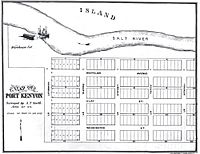Port Kenyon, California facts for kids
Quick facts for kids
Port Kenyon
|
|
|---|---|

1876 hypothetical plat map showing relative wharf location
|
|
| Country | United States |
| State | California |
| County | Humboldt County |
| Elevation | 13 ft (4 m) |
Port Kenyon is a small, quiet place in Humboldt County, California. It's called an "unincorporated community." This means it's a place where people live, but it doesn't have its own local government like a city or town does. Instead, the county helps manage things there. Port Kenyon is located about 1.5 miles (2.4 km) northwest of the town of Ferndale. It sits at a very low elevation, only about 13 feet (4 meters) above sea level.
Contents
Port Kenyon: A Glimpse into California's Past
A Busy Port in the Past
Port Kenyon was founded in 1876 by a man named John Gardner Kenyon. For a while, it was a very important place for shipping goods. Imagine big boats coming and going! The main things shipped from Port Kenyon were dairy products, like milk and cheese, that were made by local farmers. There was even a fish cannery in the community, which means they processed and canned fish there.
Post Office History
Port Kenyon also had its own post office. It was open for business from 1886 to 1899. After a short break, it reopened in 1903 and continued to serve the community until 1913. A post office was a really important part of any community back then, helping people send and receive letters and packages.
Why Port Kenyon Changed
The area around Port Kenyon faced some challenges that made it harder for the port to operate. The Salt River, which was important for shipping, started to fill up with sand and mud. This process is called "silting." When the river became shallower, it was much harder for big ships to use the port.
On top of that, the area experienced repeated flooding in the 1890s. This flooding caused a lot of problems and made it difficult for businesses to continue. Because of the silting and the floods, Port Kenyon's importance as a shipping center slowly declined. Today, it's a quiet community, but its history tells a story of a once-busy California port.



